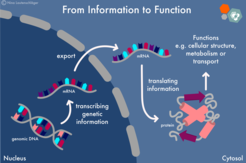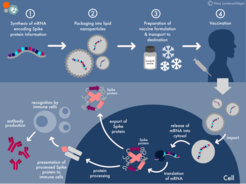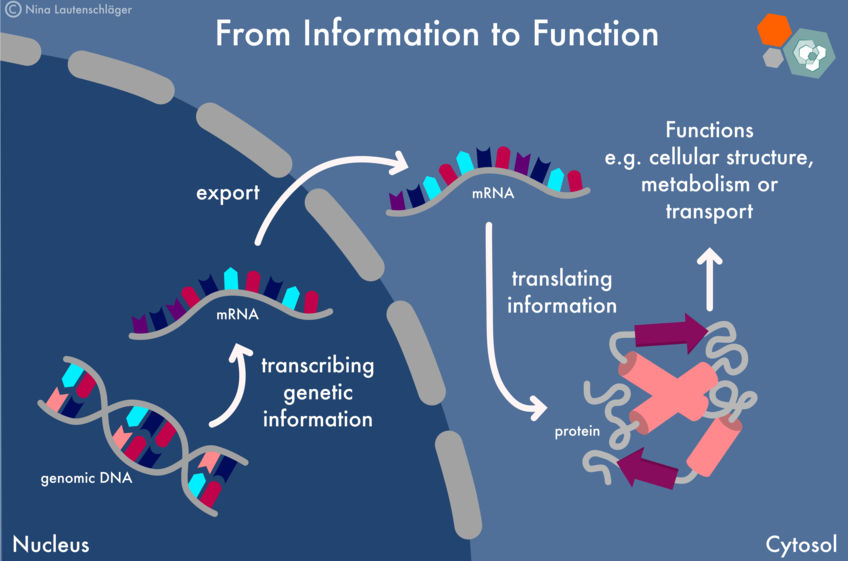mRNA Covid-19 vaccines: Facts vs Fiction
By: Maria Elisa Almeida Goes
Editing: Offspring Magazine Editorial Team
Images: Nina Lautenschläger.
As the Covid-19 pandemic completes one year, vaccines appear to be our only ticket to the “new normal”. However, we all have a grandparent, a cousin, or an uncle who is skeptical of getting their shot. It is no wonder that so many people have concerns, especially considering the amount of fake news and misinformation shared everyday on social media. Today we want to explain what mRNA based vaccines actually are, and why we should not fear them.

mRNA Vaccines: What are they?
The messenger RNA (mRNA) vaccines developed by Moderna and the consortium Pfizer/BioNtech were the first authorized Covid-19 vaccines in the western world, and also among the first mRNA vaccines ever approved for human use.
RNA molecules are central components of (almost) all the cells we have in our bodies. They are short-lived molecules essential for protein production in our cells. Structurally, RNA molecules are “similar” to the DNA in that both are made of a sugar, a nitrogen base and a phosphate. But there are many critical differences between both molecules. While DNA has two strands (which forms the popular double helix structure), RNA usually has only one strand, and thus forms no helix. Chemically, RNA molecules have a different sugar and a unique nitrogen base which is key for correct recognition by the cellular machinery. Messenger RNA molecules are a subclass of RNA that decodes the information in our DNA into a language that the cellular machinery can easily understand.
The technology of mRNA vaccines consists in packing up a small part of the viral mRNA genome inside of an oily shell. Since only a part encoding for the spike protein (a protein displayed in the outer surface of the viral particle) is included, the vaccine is non-infectious.
How do mRNA vaccines work?
It is really important to keep in mind that scientists understand a lot about RNA biology. We know, in detail, how mRNA is produced and degraded. In fact, RNA biology is understood in such detail that we can even recreate the molecule artificially. Interestingly, despite pioneering as the first mRNA vaccines ever approved, this technology has existed since the early 1990s, when the first studies for safety and efficacy started. Throughout three decades, the technology has been continuously improved, focusing on novel vaccines against the influenza virus, HIV, rabies and especially as an immunotherapy tool for fighting cancer.
In 2020, when Covid-19 pandemic broke loose, scientists already had good evidence for the most efficient delivery methods for mRNA vaccines. It “only” took them the effort of choosing which part of the SARS-CoV2 genetic material they would use to engage our immune system in the best way possible.
Similarly to other coronaviruses responsible for the common cold, Covid-19 also uses spike proteins as a key to unlock the entrance gate guarding the interior of our cells. Because of this functional importance, it made a lot of sense to choose this protein as the vaccine blueprint – the instruction to produce the immunogen.
After intramuscular injection, the oily capsule containing the spike mRNA is taken up by muscle and some immune cells. The cellular machinery uses this mRNA as instructions to massively produce spike proteins, whose bits will be presented to effector immune cells. As soon as they recognize these particles as foreign, a rapid and intense immune response is initiated, as if we are experiencing a real infection.
An interesting feature of mRNA is that in room temperature, it gets degraded within hours; our cells have sophisticated mechanisms to ensure that mRNA is destroyed after promoting protein synthesis. You might have heard about the challenges concerning the logistical distribution of these vaccines: in order to prevent degradation, they need to be stored below -20 oC. Now you might remember that our body temperature is normally 36,5 oC. Guess what happens next?

mRNA vaccines will not alter your DNA, this is why:
Concerns about the effects mRNA vaccines over the integrity of our DNA also exist. Thankfully, you do not need to worry about this. Such an event would challenge everything scientists know about basic cell biology, and is so improbable, that one can actually call it impossible.
The main reason for that is that, besides being chemically and structurally different from DNA, mRNA is located in a different cellular compartment. While DNA is enclosed in the nucleus, mRNA is produced in the nucleus, but is quickly exported to the cytoplasm with a one-way ticket: it does not come back. In fact, only specific proteins carrying “nuclear localization signals” are able to migrate from the cytoplasm into the nucleus, and mRNA vaccines definitely do not include such molecular instruction. Thus, because mRNA cannot spontaneously be trafficked to the nucleus, it cannot modify your DNA sequence. Additionally, the RNA molecule is charged and carries the same charge as the nucleus, so as our 6th grade physics taught us, like charges repel, and hence the RNA molecule is physically repelled by the nucleus.
One might also argue that there are mechanisms through which RNA can be integrated into the genome – HIV viruses being the classic example. The key differences here are that such viruses (1) express special enzymes which are able to code DNA back into RNA and (2) can associate with proteins that can traffic them into the nucleus. Neither scenario is applicable to the mRNA vaccines.
For the same reasons, mRNA vaccines cannot affect your unborn children. This would require genomic mutations in the reproductive cells – sperm and egg – since only these could potentially be transmitted to the next generation.
Speaking of children, you might have heard that Covid-19 vaccines would cause infertility in women because antibodies against the spike protein could mistakenly attack placenta cells, due to an alleged similarity with a placental protein called syncytin-1. There is no scientific evidence supporting this claim – and, in fact, the two proteins are barely similar, sharing only 4 sequential amino acids out of 538.
Still, you might want to ask why pregnant women are excluded from the vaccination campaigns, and why, during clinical trials, women are asked to use contraceptive methods that will avoid pregnancy. Again, this is not a red flag. Any clinical trial for a potential vaccine or drug will exclude children, pregnant women, old people and people with specific underlying conditions. Initially, trials are designed to obtain major insights whether the developed pharmaceutical product works at all, in healthy adults. Once safety and efficacy are determined, tests are expanded to smaller groups that at first were set aside. Excluding pregnant women from trials only shows that trials are being done systematically and following standard protocols.
Allergic reactions are very rare and likely to be kept under control
As we speak, more than 330 million doses of Covid-19 vaccines have been distributed worldwide. It is an achievement without precedent, and we hope that it will soon relieve healthcare systems. It is also no wonder that we also notice very rare adverse effects taking place. Mild and moderate adverse effects following the administration of any vaccine or medication are expected and acutely manageable. mRNA vaccines are no exception: during clinical trials, and especially after the second vaccine shot, the majority of participants report local pain, tiredness, and even light fever. Such effects are, in fact, an indication that the immune system is kicking in, and starting to respond.
Severe adverse effects, such as extreme allergic reactions (also known as anaphylaxis), have been observed upon vaccination of a few million people. More precisely, the incidence of anaphylaxis is now estimated as 11.1 cases for every million doses applied (and 80% of them in people with a history of severe allergies). Norway has recently reported the death of frail elderly patients in nursing homes “shortly” after the vaccination. All cases have been carefully investigated by health authorities, and no causality between vaccination and death could be established. It is essential to keep in mind that many frail people above 85 years of age die in nursing homes weekly, and no increase was observed in comparison to the numbers prior to vaccination. On the contrary, the many outbreaks in nursing homes across Germany and Spain have stressed how important it is to immunize the elderly. If one compares the probability of a severe allergic reaction against vaccination (0.001%) to Covid-19 case fatality rate (1-10%), it becomes clear that the benefits brought by immunization far outweigh existing risks.
So can we finally get back to normal?
One thing we still do not know about the vaccines is whether immunized people are still able to spread the virus even though they do not develop symptoms. For this reason, the scientific community agrees that until the majority of the population is immunized, we will have to continue wearing masks and practicing social distancing. Luckily, we can speed up our way back to normality by creating awareness and by volunteering to get vaccinated as soon as it is our turn. It is important to trust the regulatory agencies as they follow rigorous criteria and scrutiny before approving each vaccine. There is no reason to believe that one vaccine is safer than another, and therefore, we urge you to take whichever vaccine is offered to you.
We hope this article has successfully answered most of your doubts about mRNA vaccines. It is completely normal to have questions and look for information about the pandemic that has turned our lives upside down. But right now, it is extremely important to question everything we read or watch. Do not blindly trust any text or video that reaches you on social media - especially if they sound alarming, use uppercase letters, exclamation points, try to disguise the word vaccines by writing things like V4(!NNE$, and try to convince you of conspiracy theories. Always double check information before forwarding it. Scientists are working around the clock so that we can reach the new normal as fast as possible with rigorous safety standards and it is our duty as responsible citizens to be aware of the legitimacy of the information around us. I have not received my ticket yet, but I can't wait for it. What about you?
References
How do mRNA vaccines work?
https://www.ncbi.nlm.nih.gov/books/NBK26887/
https://biontech.de/covid-19-portal/mrna-vaccines
https://www.nature.com/articles/nrd.2017.243
Nuclear trafficking
https://www.ncbi.nlm.nih.gov/books/NBK26932/
https://pubmed.ncbi.nlm.nih.gov/15609502/
Syncytin-1
https://www.uniprot.org/uniprot/Q9UQF0
Side Effects:
https://www.cdc.gov/coronavirus/2019-ncov/vaccines/different-vaccines/Pfizer-BioNTech.html
https://www.cdc.gov/mmwr/volumes/70/wr/mm7002e1.htm
https://www.cdc.gov/vaccines/covid-19/info-by-product/pfizer/reactogenicity.html
Statistics:
https://ourworldindata.org/covid-vaccinations
https://ourworldindata.org/mortality-risk-covid

